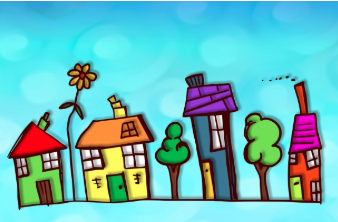
My Online Neighborhood

Overview
The internet is like one big online neighborhood that students need to learn to navigate. Just like in a physical neighborhood, there are rules that help us navigate our neighborhood well:
- ask your parents first
- only talk to people you know
- stick to places just right for you
Students will be making a comparison between the physical and online environments that they visit and how to stay safe in both.
Learning Objectives
Students will:
- Be able to compare the internet to a neighborhood
- Be able to recall three ways to be safe online
- Know that they should always ask their parents or teachers first
- Understand that they should only talk to people they know
- Know that they should stick to places just right for them
Vocabulary
Vocabulary Words:
- Online: Being online is using the internet to be connected to other people and other computers
Pre-planning
To prepare for this lesson:
- Watch the video Online Neighborhood ahead of time.
- If students don’t have practice doing think-pair-share, consider how you will prepare them, maybe having them sit with a partner.
- Bookmark, share, or pull up the Starfall ABCs website for students.
Accommodations
- See the Accommodations Page and Charts on the 21things4students website in the Teacher Resources.
-
Students can be given the choice of telling you about an online neighborhood or the three rules. Feel free to give students verbal prompts for the rules. You could also show them pictures from the video to remind them.
Steps
Directions for this activity:
-
Ask a few students to tell you about their neighborhood. You might ask questions like: who is there? Do you know them? Are there safe/dangerous places? What rules do your parents have about being in your neighborhood? (look both ways before you cross the street, don’t talk to strangers…)
-
Ask students if they’ve ever heard of an online neighborhood. What does online mean? What might an online neighborhood mean? Wonder aloud if an online neighborhood might have some similarities/differences to our own neighborhoods.
-
Tell students that you will be watching the video My Online Neighborhood and you’d like them to be thinking about their online activities (all devices) as well as their own neighborhoods.
-
Watch the video and pause it at 1:54 (right after the part about looking both ways to cross the street and before the three rules). Ask a few students to make connections between our neighborhoods and the online neighborhood. What rules seem the same?
-
Tell the students you will watch the last part of the video, which will include three rules to stay safe in the online neighborhood. They should be ready to talk about those after the video.
-
Watch the last part of the video, two times if necessary.
-
Ask students to pair up and see if they can list all three rules together. Have two-three pairs share the three rules:
-
ask your parents first
-
only talk to people you know
-
stick to places just right for you
-
-
Ask a few students to share any personal experiences. Do their parents have these rules?
-
Show students Starfall ABCs and tell them that this is a place that is just right for them because it does not collect personal information about anyone. (This website is approved by kidsafeseal.com)
-
Students can choose from any of the letter activities. You may want to model how to click the stars to navigate through each activity.
-
Use the work time to individually assess students as necessary.
-
Assessment Options
Different options for assessing the students:
- Observations
- Check for understanding
- Informal observation: you could use think-pair-share after each segment of the video to let students share with a smaller audience before a few share to the group.
- As students are working independently, walk around and ask individual students to tell you about an online neighborhood and/or the three rules for safety in an online neighborhood. (You can base this on individual student needs and time constraints.)
MITECS Competencies & ISTE Standards
MITECS: Michigan adopted the "ISTE Standards for Students" called MITECS (Michigan Integrated Technology Competencies for Students) in 2018.
Digital Citizen
2b. Students engage in positive, safe, legal and ethical behavior when using technology, including social interactions online or when using networked devices.
Empowered Learner
1c. Students use technology to seek feedback that informs and improves their practice and to demonstrate their learning in a variety of ways.
Devices and Resources
Device: PC, Chromebook, Mac, iPad
The video will play on any device that has a web browser.
Starfall requires Flash, so it will not work on an iPad unless the Starfall ABCs app is purchased.
Websites:
My Online Neighborhood
CONTENT AREA RESOURCES
ELA
Starfall is a great ELA resource that is very engaging and safe for students, but also reinforces great letter naming and sound skills.
CREDITS
This task card was created by Sarah Schreuder, Allendale Public, November 2018. Updated October 2023.


